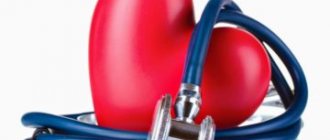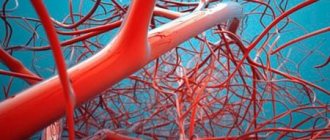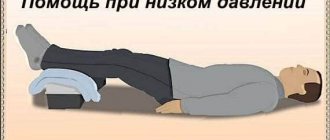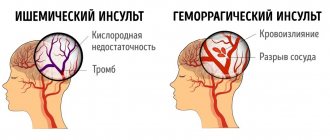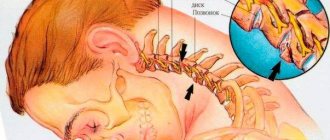Treatment
ICP is quite treatable at home. Treatment should begin with taking diuretics, which remove excess fluid from the body, thereby relieving swelling.
Solution for infusion Albumin
Albumin will improve microcirculation between plasma and brain tissue. Magnesia will have a diuretic effect and dilate peripheral blood vessels.
If there is a risk of cerebral edema, the doctor prescribes Dexamethasone and Prednisolone.
Self-massage
You can improve your condition with intracranial pressure at home using self-massage of the head.
The head is clasped with the hands so that the thumbs are placed on the back of the head.
Using circular movements, knead the points where the thumbs touch the head.
An equally effective way to reduce intracranial pressure at home is to massage the neck muscles. They do it every day for fifteen minutes.
Thermal treatments
Mustard baths
To prepare, two teaspoons of mustard powder are placed in a cloth bag, dipped in a bowl of warm water and squeezed out.
The legs are lowered into the liquid up to the middle of the shins. The procedure lasts 20 minutes, it will reduce the filling of the brain vessels, and the increased pressure inside the skull will decrease.
To quickly get rid of headaches, you can prepare a strong decoction of bay leaves and do regular inhalation. Ten minutes after the start of the procedure, a significant improvement in well-being will occur.
Any manipulations should begin only after consultation with a doctor.
People's Pharmacy
Traditional medicine can significantly alleviate the condition of patients with ICP.
The most popular recipes for lowering intracranial pressure at home:
- herbal infusions . A mixture of mint, valerian, lavender, sage, St. John's wort, horsetail (a tablespoon of each herb) is poured with water, boiled for five minutes and left for half an hour. Drink a quarter glass of medicine three times a day. Course – one month;
- alcohol tincture of clover . Dried flowers are poured into a container and filled to the top with vodka. Infuse the product for two weeks in a dark place. After straining, take the tincture twice a day, one teaspoon, with water;
- garlic-lemon water . Three lemons with peel are ground through a meat grinder, three chopped heads of garlic are added to the mixture. Mix the ingredients, add 1.5 liters of boiled water and leave for 24 hours. Drink a tablespoon of medicine before breakfast. The course of treatment is three weeks;
- decoction of mulberry branches . Four tablespoons of chopped branches are poured into a liter of boiling water and simmered in a water bath. The broth is poured into a thermos and left for three hours. After filtering, the liquid is diluted in half with water and drunk half a glass three times a day;
- drops of garlic and milk . Six cloves of garlic are crushed and poured into a glass of milk. The mixture is boiled for five minutes, cooled and filtered. Place three drops of the medicine in each ear. After thirty seconds, the head is tilted to allow the liquid to flow out.
A compress of alcohol and camphor oil is applied to the head until the pain symptom decreases. The oil relieves swelling, promoting the outflow of fluid. Alcohol has a cooling effect, while blocking painful sensations.
Nutrition
The main principle of nutrition in pathology is adherence to a salt-free diet.
This ingredient retains excess fluid in the body. Garlic and lemon will help reduce blood pressure.
Foods high in potassium, such as potatoes and dried apricots, will help alleviate the patient's condition.
It is useful to use to prevent intracranial pressure. The plant not only enhances intestinal motility, but also cleanses the blood, reduces cholesterol, strengthens blood vessels, increases immunity, improves the functioning of the thyroid gland, improves cerebral circulation and memory.
Peppermint oil regulates vascular tone. Ten drops of the product are diluted in a glass of water and taken twice a day after meals. When applied to the temples, it will relieve headaches and nausea.
Ways to reduce high ICP
If a person suffers from hypertension, loved ones should know how to quickly lower blood pressure and what to do before the doctor arrives. Treatment should only be prescribed by a specialist after diagnosis. You cannot fight the pathology on your own due to the danger of the condition.
You can reduce increased intracranial pressure using the following methods:
- drug therapy;
- surgical treatment;
- physiotherapy;
- diet;
- gymnastics;
- traditional methods.
Reducing ICP with medication
How to relieve intracranial pressure with medications? Treatment tactics usually depend on the severity of the disease that provoked the increase in ICP. Drug therapy involves taking not just one drug, but a complex of drugs. Medicines from the following groups are usually used to lower ICP:
Experts advise treating increased ICP immediately after detecting a pathology; they prescribe medications that normalize blood circulation in the brain and activate the body’s removal of excess fluid. The following medications help doctors achieve these goals:
- Diuretics. They will help remove excess fluid from the body. But their use is dangerous due to the leaching of potassium from the body, but this element is necessary for the coordinated operation of all systems. Doctors limit the intake of diuretic medications. The most common are Furosemide, Spironolactone, Hypothiazide, Torasemide, Lasix, Diacarb, Eufillin.
- Adrenergic blockers. Their role is to normalize the transmission of nerve impulses. This helps reduce brain swelling. Among the drugs in this group, Carvedilol, Nibelet, Anaprilin, Bisoprolol, Doxazosin, Losartan, Nicergoline, Atenolol, Propranolol, Enalapril are often prescribed.
- ACE inhibitors. They lower the fluid level inside the brain and help lower blood pressure. The most commonly used are “Capoten” and “Captopril”.
- Calcium antagonists. They are usually prescribed along with diuretic medications. These drugs help improve your general condition. Doctors often prescribe them to older people, because they are the ones who most often suffer from increased ICP. This group of medications includes Cordaflex, Verapamil, and Amlodipine.
- Sedatives (Notta, Glycine);
- Drugs to improve blood circulation inside the brain. Most often, doctors can prescribe Sermion, Vinpocetine, and Cinnarizine.
- Hot injections. The purpose of such injections is to remove excess fluid, normalize blood circulation, and dilate blood vessels. Doctors perform injections using magnesium sulfate, calcium chloride, and calcium gluconate.
- Plasma substitutes (Albumin is most often prescribed).
- Hormonal medications (“Dexamethasone”).
- Vasodilators.
Glycerin effectively lowers blood pressure. It removes a lot of fluid after penetrating the bloodstream. Taking this medicine orally reduces cerebral edema and decreases intracranial and intraocular pressure.
Treatment of pathology in children
In newborns, this pathology is considered a consequence of difficult childbirth and difficult pregnancy. The main signs of the disease in children under one year of age are:
- constant whims of the baby;
- poor weight gain;
- disproportionate head size.
To lower ICP in an infant, you should adhere to the following rules:
- daily walks with the baby outside, in the fresh air;
- breastfeed your baby for as long as possible;
- use medications that help improve the functioning of the central nervous system and blood circulation;
- maintain a daily routine;
- conducts physiotherapeutic procedures for the baby (swimming is preferred).
Important: When increased intracranial pressure is caused by a congenital pathology, surgical intervention cannot be avoided.
Folk remedies
It is quite possible to lower intracranial pressure at home. For this, experts recommend using not only medications, but also certain folk recipes. For this purpose, you can even eat certain foods (fruits, berries, vegetables):
- lemon;
- Rowan;
- garlic;
- dried apricots;
- potato;
- rose hip;
- cranberry;
- viburnum.
If you add honey to crushed berries, the effect of lowering intracranial pressure will appear faster.
Healing herbs also help reduce high ICP:
- Lavender. To prepare the medicine, use dry herb (1 tbsp), place it inside a container, and pour boiling water (0.5 l). It is recommended to leave for about an hour. After removing the sediment, drink the liquid three times a day, one tablespoon at a time. To normalize ICP you need to take a course of 3 weeks.
- Bay leaf. A decoction is prepared from several leaves of this plant and water (1.5 cups). Bring to a boil and use for inhalation. You need to inhale the vapors for two weeks.
- Clover. We prepare medicine from dried flowers, which we take enough to fill a container with a volume of 0.5 liters. For the tincture you need vodka and alcohol to fill the inflorescence to the edges. It is enough to withstand for 2 weeks, after that we strain the tincture, take it three times a day in a dosage of 1 tsp. The duration of the treatment course is 1 month.
You can also use other traditional medicine recipes that can relieve a patient from intracranial pressure:
- A mixture of dried fruits (dried apricots, raisins) + nuts (almonds, walnuts) + honey. The resulting mass is consumed on an empty stomach (30 g is enough).
- Birch sap. This liquid has a diuretic effect; it can replenish the lack of vitamins and minerals in the body. You should drink juice every day at any time. You can drink 1 – 2 glasses per day.
- Lemon + honey + garlic. A unique mixture is prepared from citrus juice (150 g), liquid honey (350 g), crushed garlic (2 cloves). We initially mix the components, then leave them in a cool, dark place if possible for 10 days. Drink the resulting mixture in the morning and in the evening only after meals. To achieve the expected effect, use a dosage of 1 teaspoon.
Gymnastics and other procedures
Usually, people turn to traditional methods when the disease is already chronic. Help reduce vascular tone:
- massage in the neck and head area. In the head area, it is recommended to perform a light massage using your fingertips;
- rubbing hands, feet;
- cold compresses on the forehead;
- special therapeutic exercises;
- quitting smoking, coffee, alcohol;
- dieting.
At home, it is convenient to use special gymnastic exercises to reduce intracranial pressure. The main thing is to perform them technically correctly. Let's look at the most common exercises:
- We wrap our hands around a cylindrical stick and place it behind the head. Then we stroke the muscles in the neck area with this stick. This massage takes about 15 minutes. Exercise helps normalize intracranial pressure. It is important to do gymnastics regularly, several times a day.
- We perform head tilts, they need to be done alternately in each direction. We also do head rotations. These exercises should also be repeated several times a day. What you should pay attention to is the smoothness of the movements performed.
In addition to gymnastic exercises, you can use external methods of lowering ICP:
- Head massage. It is carried out using flower dust and honey. These components are mixed (recommended proportion 2:1). They are infused for about three days. After this time, the mass is rubbed into the following areas of the head:
- back of the head;
- whiskey.
- Rubbing aromatic oil (lavender) into the temple area. In this case, you need to make soft massage movements.
- Mint wraps. Before the procedure, you need to prepare a decoction of mint. Boil water (1 liter) and mint (1 glass) for 15 minutes. After cooling the broth to 50 degrees, dip napkins (cotton) into it and apply them to the head. When the napkins cool down, they should be moistened again with a warm solution. This wrap is performed until the prepared broth is finished.
- Cold compress. It is applied to the ear area.
- Foot bath (mustard). Preparation involves placing dry mustard (2 tbsp) inside a fabric bag. This bag of mustard is kept in a container of hot water (a basin for the procedure) and squeezed out. They lower their feet into the water, just hold them there for 20 minutes (not worth it anymore). During the procedure, the legs are covered with a terry towel.
back of the neck;
After rubbing the healing composition into the dermis of the head, neck, cover the treated area with a warm scarf and leave it like that until the morning. We do this massage for a month.
Did you like the article? Save it!
Still have questions? Ask them in the comments! Cardiologist Mariam Harutyunyan will answer them.
Ivan Grekhov
Graduated from the Ural State Medical University with a degree in General Medicine. General practitioner
How to cure intracranial pressure
Modern medicine knows several ways to get rid of intracranial pressure.
The first method is surgery, but it is only indicated in cases of acute ICP resulting from traumatic brain injury or stroke. In other cases, doctors prescribe medication.
Treatment with drugs is prescribed only based on the results of the examination . Depending on the cause of intracranial pressure, the patient is prescribed medications to eliminate the root cause and, in parallel, medications that help directly with ICP.
Let's look at what pills to take for ICP:
- Diuretics (diuretics) . Most often, patients are prescribed Furosemide, Hypothiazide, Lasix, Diacarb or their analogues with other commercial names. Some drugs help remove potassium from the body, which is necessary for the contraction of the heart muscle. Therefore, Asparkam or Panangin are used together with diuretics. It is also possible to use an osmotic diuretic such as Glycerol. It is based on glycerin, which is well tolerated by all categories of patients. The drug is often used in neurological practice and has proven effectiveness in the treatment of ICP in children. Glycerol takes effect within 10 minutes. A similar drug, Mannitol, is used in medical practice for TBI.
- Vasodilators . They are used as a means of removing blockages in the outflow of cerebrospinal fluid, lowering blood pressure, thereby reducing the flow of fluid to the brain. For faster action, they are used together with nicotinic acid.
- Drugs from the group of beta-blockers . The principle of action is based on a disruption in the transmission of the nerve impulse responsible for narrowing the lumen of the vessel wall. As a result, blood is deposited around the periphery and cerebral edema decreases. In practice, such drugs as Anaprilin, Nebilet, Bisoprolol, Carvedilol are often used. Some drugs are contraindicated in patients who have renal or liver failure, asthma, or heart block, since they are also alpha-1 blockers. In addition, all drugs in this group are contraindicated in pregnant women and are not used in the treatment of ICP in children.
- Angiotensin-converting enzyme (ACE) inhibitors are drugs with a broad spectrum of action, also used in medical practice to eliminate ICP. Examples - Captopril, Enalapril, Quinapril, Benazepril, etc.
Is it possible to use traditional medicine?
We have indicated how to reduce intracranial pressure at home, quickly and effectively - use medications, some of which effectively cope with symptoms and pain in 10-20 minutes.
If you are looking for ways to reduce and deal with intracranial pressure using alternative medicine, then you can use a decoction of clover, lavender, and mulberry leaves .
Decoctions are prepared as follows: 2 tsp. plants are filled with 500 ml of water and infused for an hour. The decoctions are taken one tablespoon once a day for a month.
We do not adhere to the position of the need for self-treatment, despite the fact that many claim the effectiveness of these remedies. It must be remembered that intracranial pressure is not rhinitis, not a cough, not a common cold.
This is a disease that directly affects the brain, which appears due to a variety of reasons - which is why traditional medicine should only be used if it is confirmed by a doctor.
How to reduce ICP at home
There are proven folk remedies that will help in the fight against increased intracranial pressure.
- Mulberry branches.
Pour four tablespoons of chopped mulberry branches into a liter of boiling water and simmer in a water bath. Then pour the entire mixture into a thermos and cover tightly with a lid. Let it brew for about three hours. Then strain the broth, dilute it in half with water and drink half a glass 3-5 times a day. - Poplar buds.
This is a good vasodilator. Young poplar buds are collected in the spring and dried for future use so that this medicine lasts for the whole year. Dry the poplar buds on newspaper and place in a canvas bag. Store in a dry place. If necessary, pour 5 tablespoons of fresh or dried buds with a liter of boiling water and boil for 5-7 minutes. Then cover the container with a lid so that the buds steam and impart their beneficial properties to the broth. Then strain the mixture and drink 200 ml twice a day on an empty stomach. - Tincture of alcohol and camphor oil.
If you need urgent pain relief, prepare the following compress. Take camphor oil and 70% alcohol in equal parts. Mix the liquids and heat them over the fire. Soak gauze or a clean cloth in the liquid and apply it to your head (in the hair area). Keep the compress until the pain subsides. Camphor oil perfectly relieves swelling and promotes fluid outflow. And alcohol gently cools, blocking pain. - Laurel inhalations.
To quickly get rid of severe headaches, you need to prepare a strong decoction of bay leaves. Then you need to cover yourself with a towel over a basin or cup and inhale the steam deeply. Within 10 minutes after the start of inhalation you will feel relief. - Ear drops made from garlic and milk.
6-8 large cloves of garlic must be chopped using a grater or meat grinder. Pour half a glass of milk over the garlic and boil the mixture for five minutes. Then the prepared product must be cooled and strained. Place 2-3 drops in each ear. After 30 seconds, tilt your head to allow the liquid to flow out. - Herbal collection.
Various herbs have anti-inflammatory and analgesic properties. To reduce ICP, you can take valerian, sage, St. John's wort, motherwort, horsetail, mint, eucalyptus, lavender. Prepare a strong, rich decoction from one or more herbs. Drink half a glass of it several times a day. For sweetness and additional benefits, you can add honey to the broth. - Clover tincture.
This is a very effective remedy for relieving headaches due to increased ICP. If you often suffer from headaches of this nature, this tincture should be in your refrigerator at all times. Fill a light-proof glass bottle with dry or fresh clover blossoms. Fill the flowers with alcohol and place them in a cool, dark place for a couple of weeks. Then the tincture can be strained and diluted in half with water. If severe pain occurs, drink 100 ml of tincture. The prepared medicine can be stored in the refrigerator for up to two months. - Parsley, bearberry, oregano.
This remedy will help get rid of constant headaches from increased ICP. If you drink it regularly, you can completely forget about ICP for a while. Chop a couple of bunches of parsley, a handful of bearberry and oregano. Mix the herbs and pour boiling water over them. It is better to brew the composition overnight in a thermos. Drink half a glass of this remedy on an empty stomach every morning. The course of treatment is two months. After just a couple of weeks of regular use of this decoction, you will notice that headache attacks have become less intense and frequent.
Drug treatment of ICP
Treatment of ICP with special medications gives good results even at home. Before using any remedy, you should consult a doctor and, if possible, undergo a full diagnostic examination to determine the presence of ICP, as well as to rule out other diseases in which taking certain medications may cause more harm than good. As a rule, doctors prescribe treatment for ICP using the following groups of medications:
- Neuroprotectors are a group of special drugs that prevent damage to brain neurons resulting from the action of pathogenic factors (in this case, increased cerebrospinal fluid pressure). Among the most popular drugs it is worth noting Glycine, Semax, Mexidol, Ebselen and Emoxipin.
- Glucocorticosteroids are hormones of the steroid group, synthetic or natural origin. They belong to a class of hormones that are produced by the adrenal cortex. Among the representatives of this group, Prednisolone, Mometasone, and Dexamethasone are popular.
- Nootropic drugs. Also known as neurometabolic stimulants, medications that have a positive effect on higher nervous activity and cognitive functions. You can reduce the impact of ICP with the help of nootropics such as Piracetam, Pantogam, Nootropil and their analogues.
- Vascular strengthening agents - Sermion, Cavinton, Cinnarizine.
- In some cases, doctors recommend the use of sedatives such as valerian or motherwort.
Please note that the unsystematic use of hormonal drugs without prior consultation with a doctor is strictly prohibited. It is also not recommended to increase or decrease the dosage of the above drugs.
Methods for reducing intracranial pressure
Veroshpiron and furosemide will help to quickly relieve intracranial hypertension. Losing excess weight is a prerequisite for normal circulation of cerebrospinal fluid.
No-spa, tempalgin, and spasmolgon will help relieve headaches and spasms. The neurologist will give precise recommendations on how to reduce intracranial pressure quickly and safely.
Medical massage of the collar area and self-massage, traditional medicine recipes reduce hypertension.
- You should cover your head with your hands as much as possible. In this case, the thumbs should rest against the back of the head. Massage the occipital area with circular movements for 15 minutes. The exercise is repeated at least twice a day.
- An effective home recipe is to prepare infusions from the fruits of hawthorn and rose hips. Lavender, St. John's wort, and meadow clover will reduce hypertension. The healing properties of horsetail, sage, and peppermint will eliminate swelling and headaches. Dried herbs are poured with hot water and boiled for 2 - 3 minutes. The decoction is infused for half an hour. The medicine should be taken 50 ml three times a day.
- A well-known remedy is an alcohol tincture of meadow clover. Fill the container halfway with dried inflorescences, add vodka or alcohol. Store the container in a cool place, protected from light. After 14 days the tincture is ready.
- Preparation of garlic water. Chop three heads of garlic and mix with three ground lemons. Add one and a half liters of boiled water, leave for 24 hours. Take 1 tablespoon in the morning before meals. Duration of treatment – 3 weeks.
The listed measures serve as a temporary measure to reduce intracranial pressure at home or as an addition to drug therapy. The treatment tactics for increased ICP will be developed by a neurologist after a medical examination.
Related materials:
- Herbs for high blood pressure
- How to normalize blood pressure using folk remedies
- High blood pressure massage
- Effective folk remedies for hypertension
- Secondary arterial hypertension
Share on social networks
Important: The information on the site is not a substitute for medical advice!
Compresses, inhalations and tinctures
To prepare the tincture you will need 100 g of crushed lavender herb and 100 g of olive oil.
The ingredients are mixed and left for 20 days in a dark place. After this, the mixture is filtered through cheesecloth and 150 g of aloe juice is added to it. The resulting product can be taken orally, 2 teaspoons per day or instilled into the nose. To relieve pain with increased intracranial pressure, an alcohol compress based on camphor oil will help. To prepare it you will need 50 g of 70% alcohol and 50 g of camphor oil. The mixture should be slightly heated in a water bath. Soak a cloth or gauze with the resulting solution and place it on the scalp. Wrap your head in plastic wrap and cover with a towel. Keep the compress on your head for 2-3 hours. After this, you need to wash your hair with shampoo. The procedure should be performed before bedtime 10 times with an interval of 1 day.
Inhalation to relieve headaches with increased ICP. 30 bay leaves are poured into 0.5 liters of boiling water and left for 5-10 minutes. Then we breathe over the pan for 15 minutes, covered with a towel.
An effective remedy for headaches is a decoction made from garlic and milk. 10 cloves of garlic need to be grated on a fine grater, pour in 100 ml of milk and bring to a boil. The resulting broth is cooled and filtered. The resulting mixture is instilled into each ear, 5-10 drops. After 1 minute, it is necessary for the liquid to come out of the ear. To do this, you should tilt your head.
Symptoms of high intracranial pressure
Clinical hypertension syndrome may differ with different localization and prevalence of pathological processes, and also depends on the speed of their development. Classic symptoms of increased intracranial pressure include:
- frequent headaches with increasing severity, may be complicated by cough, painful urge to urinate and defecate, reminiscent of the Valsalva maneuver ;
- interruptions of sleep due to headaches, forced positioning of the head;
- nausea;
- repeated vomiting;
- disturbances of consciousness;
- fog before the eyes, possibly due to venous stasis or optic disc edema;
- stunned;
- decreased mental performance;
- respiratory dysfunction;
- bradycardia and increased blood pressure;
- convulsive seizures.
Long-term intracranial hypertension can provoke visual impairment, as well as other symptoms:
- loss of appetite ;
- constant drowsiness ;
- difficulty waking up in the morning;
- impaired concentration;
- positive reaction to the pathological Babinski reflex .
Symptoms of increased intracranial pressure in infants
The first signs in an infant are a large head circumference, protrusion of the fontanel, increased reflexes and tonicity, the child cannot look up. With chronic hydrocephalus, manifestations of spastic lower limbs may be observed, and subsequently incontinence and learning problems may develop.
Unlike adults, in children, the pathology subsequently causes a triad of clinical manifestations: headaches of a paroxysmal nature (onset at 5-7 years), oculomotor disorders and visual impairment (most often paralytic convergent strabismus , nystagmus ).
Applicable therapy methods
It is necessary to combat intracranial pressure. In order for the doctor to prescribe treatment, you need to know what level of ICP the patient has. It will not be possible to measure it with a tonometer, as we do with high blood pressure. There must be a device that can do this. This can be done using a tomograph.
But the cost of such a measurement will be very expensive, so intracranial pressure is measured very rarely in this way. You can get an idea of the level of ICP using an electroencephalogram. In this case, the bioelectrical activity of the brain is assessed. An ophthalmologist can also indirectly determine high ICP.
When the indicator increases, swelling of the eyeball occurs. Based on this sign, we can say that the blood pressure may be elevated. After this, additional examinations are prescribed to clarify the diagnosis.
The question arises of how to reduce ICP quickly enough to relieve unpleasant symptoms. Since the disease is based on a large amount of water, diuretics can alleviate the patient’s condition. But they cannot always be taken and not for all patients.
Therefore, before starting to take diuretics, you should consult your doctor. How to treat the disease depends on the underlying disease, the manifestation of which is increased intracranial pressure.
Very often you have to solve the problem of how to reduce intracranial pressure at home. First of all, it should be noted that all home remedies cannot cure the disease. They can only temporarily alleviate the condition. But the reason why the pressure rose will still remain. And this reason needs to be identified.
How to lower intracranial pressure when there are no pills or medicinal decoctions at hand? The fight against high blood pressure should be regular.
conclusions
To normalize intracranial pressure, treatment with folk remedies can only be used in combination with traditional medicine. No one excludes the effectiveness of herbal remedies. However, not in all cases their healing properties are confirmed at the biochemical level.
When treating cerebral hypertension, especially if it manifests itself in adolescence, it is better to use only traditional methods, since some changes occur in the bones of the skull during this period. A persistently elevated blood pressure level may occur due to the healing of post-traumatic damage to the brain structure. You should also understand that in the presence of stable hypertension, getting rid of intracranial pressure at home forever, sadly, is very difficult. Although this can be difficult to do even during traditional treatment. Each hypertensive crisis worsens the condition of the human nervous and cardiovascular system many times over. It follows that round-the-clock monitoring of this indicator and taking antihypertensive drugs is necessary.
Intracranial pressure treatment with folk remedies
Due to the fact that constant pressure is placed on the brain, serious disturbances in its functions occur. A person’s intellectual capabilities, energy level, and quality of life decrease. Therefore, it is necessary to use various means and methods to normalize the level of ICP, including using traditional medicine methods.
The most reliable folk remedies for the treatment of intracranial hypertension are considered to be a mixture of honey and lemon juice with water, infusions of rose hips, plantain, hawthorn, valerian, motherwort, and alcoholic tincture of clover. They drink kidney teas that stimulate the functioning of the kidneys and adrenal glands, as well as herbal decoctions with a mild diuretic effect (horsetail, knotweed and others).
An effective preventive measure is peppermint oil, taken in the amount of 10 drops per glass of water twice a day after meals. It effectively affects the condition of blood vessels and maintains their tone.
When ICP increases, mustard baths help a lot. One or two tablespoons of mustard powder are diluted in a bowl of warm water and the feet are immersed there for 10-20 minutes. This simple procedure will reduce the filling of the blood vessels in the brain and help reduce intracranial pressure.
For self-massage of the head, take flower pollen and mix it with honey (2:1). The mixture is kept in a dark place for three days, and only after that it is suitable for consumption. You should gradually rub the prepared product into your head and back of your neck. Then wrap everything in a towel, and repeat this daily for a month.
A mixture of alcohol tinctures will improve blood circulation in the brain tissue and help reduce cranial pressure. It is necessary to mix tinctures of the following medicinal plants:
- eucalyptus (1/4 part);
- mint (1/4 part);
- valerian (1 part);
- motherwort (1 part);
- hawthorn (1 part).
The mixture is placed in a darkened glass container, a little clove is added and left to infuse. After two weeks, start taking 25 drops in a tablespoon of water three times a day. The prepared remedy eliminates venous spasm and improves the outflow of cerebrospinal fluid.
Unconventional methods will help temporarily relieve pain caused by intracranial hypertension, but will not eliminate the underlying disease. Therefore, you should not resort to self-medication. Folk remedies are only a component of complex therapy prescribed by a doctor.
Treatment
Treatment should be carried out only after the cause of high blood pressure has been determined. If this is a concomitant symptom of another disease, it is necessary to fight it. But symptomatic treatment of ICP is also of great importance.
If increased ICP has serious causes - atherosclerosis, hormonal imbalance, it is these that should be eliminated, and not secondary symptoms.
Surgical methods
They are used in severe cases when other methods are ineffective, or the situation is in a critical phase.
The most common type of surgery is bypass surgery. It involves the installation of a special tube through which an excess amount of cerebrospinal fluid is pumped from the skull into the abdominal cavity.
Among the disadvantages of this method is the risk of catheter failure or clogging. The risk of possible complications also increases. In the case of children, it is necessary to periodically increase the length of the catheter as the child grows.
The liquid can also be drained into a special sterile container. A more complex, but reliable method is when the cerebrospinal fluid is diverted from the ventricles into the space between the membranes near the base of the brain. This method has a minimal risk of complications.
Drug methods for reducing intracranial pressure
The use of medications to reduce intracranial pressure can begin only after a diagnosis has been established.
First, in any case, you need to undergo a medical examination and visit an experienced neurologist.
Causes of increased intracranial pressure
It should be noted that increased intracranial pressure may be a consequence of an excess amount of cerebrospinal fluid, which puts pressure on the brain.
However, this is not an independent disease and is caused by completely different diseases. Some of the main reasons for increased ICP are:
- congenital pathologies;
- various types of inflammation: meningitis, encephalitis, hydrocephalus;
- violation of metabolic processes, which reduces the amount of absorbed fluid;
- a large amount of excess fluid in the body, which causes the amount of cerebrospinal fluid to increase;
- infectious diseases: bronchitis, otitis, gastroenteritis, malaria;
- brain hypoxia as a result of various injuries;
- severe intoxication of the whole body;
- excess vitamin A;
- excess weight.
In addition, a common cause of high blood pressure is taking certain hormonal medications, such as thyroxine.
IMPORTANT!
Normally, intracranial pressure ranges from 7.5 to 15 mmHg. Values higher or lower indicate deviations from the norm. Pressure above 30 mmHg leads to cessation of blood circulation and brain activity.
general information
The human brain is a heterogeneous structure consisting of medulla, meninges, cerebrospinal fluid (CSF) and blood vessels. All this is located in a closed cranium with rigid walls. What is intracranial pressure (ICP)? This indicator is made up of the following components:
- CSF pressure - this fluid is constantly produced in special vascular plexuses and absorbed in the venous sinuses. Liquor flows around the cerebral hemispheres from above and accumulates inside in its ventricles, being in constant circulation.
- Turgor (elasticity) of the medulla depends on the inflow of arterial and outflow of venous blood.
- Hydration (presence of fluid) inside cells and osmotic pressure in the extracellular space.
All these components influence the value of ICP. The norm for adults is considered to be values from 3.5 to 15 mm Hg. Art. A healthy person in a calm state does not feel this pressure. You cannot measure it (unlike blood pressure) yourself at home; this can only be done during a lumbar puncture or open brain surgery.
The acute form of intracranial hypertension usually develops as a result of injuries, cerebral hemorrhages, or tumor decompensation, and is therefore characterized by a rapid deterioration in a person’s condition and requires emergency medical care. An excessive increase in pressure is dangerous due to the dislocation of individual brain structures and disruption of the function of vital centers. In this case, it is possible to quickly relieve symptoms and relieve intracranial pressure only in a hospital.
The chronic form is encountered more often; it develops gradually against the background of torpidly growing tumors, cystic formations, or as venous outflow disorders progress; there is a benign pathology with an unknown etiology. The clinic in this case is characterized by moderate severity of manifestations with periodic crises. An increase in pressure inside the skull can be judged by a certain set of clinical phenomena, the main of which are:
- a bursting headache in the area of the frontal lobes, which begins in the early morning hours and gradually passes by the middle of the day; the pain may return again at night;
- accompanying symptoms are nausea, vomiting in the morning, a feeling of pressure on the eyes, decreased hearing and visual disturbances, dizziness, extraneous noises in the head.
People with chronic increased intracranial pressure are characterized by weather sensitivity, they almost always have chronic fatigue, sleep disorders, irritability, and often increased blood pressure.
The severity of clinical symptoms depends on the degree of intracranial hypertension and the body’s compensatory reserves.
Causes
Increased intracranial pressure is a consequence of an increase in the amount of cerebrospinal fluid (CSF). The role of this fluid is to protect the brain, the membrane of this organ, from injury. It also provides nutrition and breathing to nerve cells.
Every day the body produces a liter of cerebrospinal fluid. Under normal conditions, nerve cells and the brain function smoothly. In this case, intracranial pressure (ICP) is in the range of 3 – 15 mm Hg. Art. The presence of deviations in these indications is a reason for immediate therapy. Why is a condition like hypertension dangerous? It can cause damage to blood vessels, kidneys, heart, and cause stroke or heart attack.
Of the main reasons that provoke an increase in intracranial pressure, you need to indicate:
- genetic predisposition;
- meningitis;
- drug poisoning;
- alcohol abuse;
- CNS diseases;
- hydrocephalus;
- hematomas, tumors;
- excess weight;
- stroke;
- cerebrovascular accident;
- innate characteristics of the body.
Another cause of increased ICP is traumatic brain injury.
Traditional methods
Treatment of intracranial pressure in adults or children is carried out differently depending on the cause that provoked the appearance of this syndrome, as well as on the severity of symptoms and the severity of the patient’s condition.
There are two main directions - conservative and surgical. The first involves the use of drugs, the second - operations.
Conservative therapy
Drugs to reduce intracranial pressure are prescribed to patients as part of conservative therapy for chronic pathology without significant progression of symptoms. The number of medications that are effective for high pressure inside the skull is not that large. The basis is diuretics, the choice of which depends on the severity of the patient’s condition.
Drugs such as Mannitol and Mannitol will help to quickly relieve severe symptoms of increased cerebrospinal fluid pressure. These are osmotic diuretics that are administered intravenously by stream or drip in a hospital setting at a dose of 0.5 to 1.5 g per kilogram of body weight. They provide an increase in the concentration of dissolved active particles in the blood plasma (osmolarity), which promotes the transport of fluid from tissues, including from the brain, into the vascular bed. The drugs have contraindications and are therefore not suitable for self-medication.
How to lower intracranial pressure at home? The patient’s condition can be alleviated by influencing the basic mechanisms:
- ensure the removal of excess fluid - diuretics Furosemide (Lasix), Diacarb, Hypothiazide, Veroshpiron are suitable for this;
- improve venous outflow - medications are used to increase the tone of venous vessels (Phlebodia, Troxevasin), as well as Eufillin, caffeine-containing products (Askofen, Caffetin, etc.).
All medications must be used after consultation with your doctor.
The use of such drugs as Cavinton, Nootropil, Glycine and others has nothing to do with the mechanisms of increasing intracranial pressure, which means it cannot solve the question of how to relieve the symptoms of cerebrospinal fluid hypertension and alleviate the patient’s condition.
Surgery
If drug therapy is ineffective or the patient’s condition is serious and pressure is rapidly increasing, surgical treatment methods are used. Surgical interventions are performed in the following modes:
Emergency operations:
- Ventricular puncture and installation of catheters in the lateral ventricles of the brain to remove excess fluid.
- Decompression trepanation is a palliative measure, which is the creation of an artificial “window” in the temporal bone of the skull to reduce pressure on the brain, used in inoperable cases.
- Planned operations include bypass surgery or the creation of an artificial path for the exit of cerebrospinal fluid. To reduce pressure, a special device (shunt) is used, which is inserted through a hole in the patient’s skull. With the help of valves, the amount of cerebrospinal fluid absorbed by the ventricle of the brain is regulated; the excess is directed through the catheter from the skull to the patient’s abdominal cavity. Contraindications are the presence of an acute infectious disease and functional heart failure.
How to relieve intracranial pressure with medications
Intracranial pressure lowering agents are primarily diuretics. Their use leads to the removal of fluid from the body, thereby reducing the amount of cerebrospinal fluid, thereby reducing the pressure inside the skull.
In addition, medications that dilate blood vessels and promote blood outflow during venous stagnation, glucocorticosteroids (for cerebral edema), plasma substitutes (to improve blood circulation), and antispasmodics can be used.
All these drugs must be used strictly as prescribed by a doctor, as they have serious side effects.


